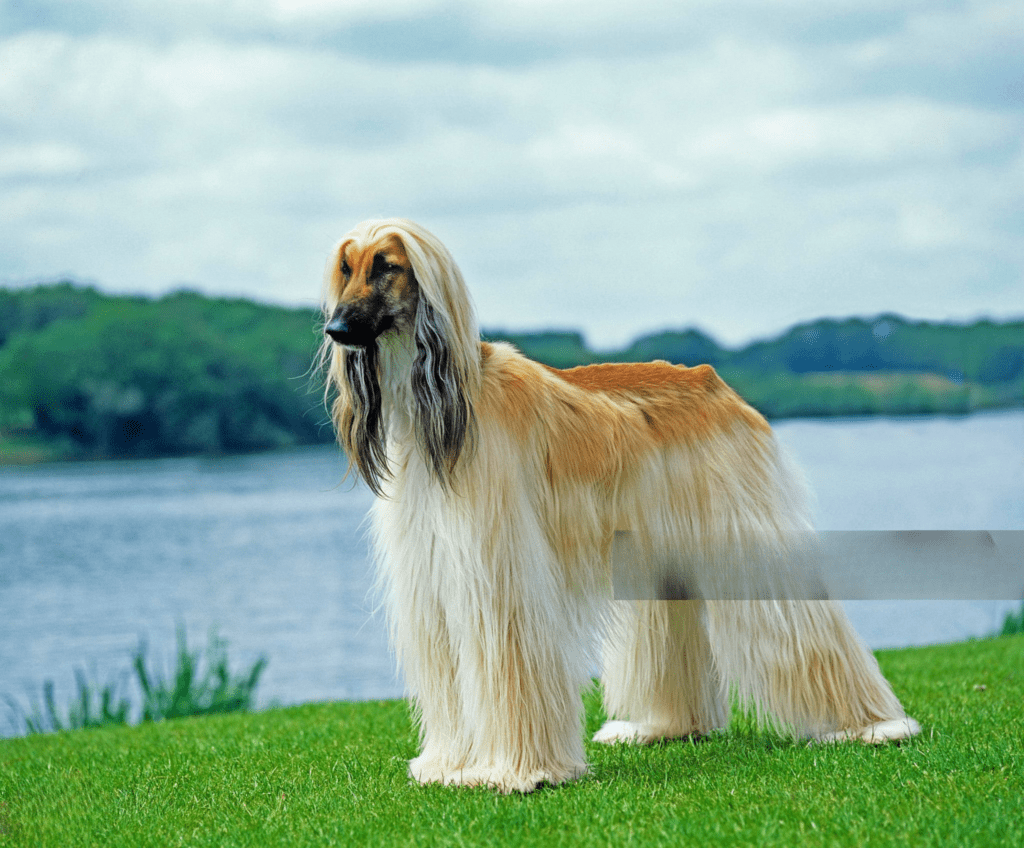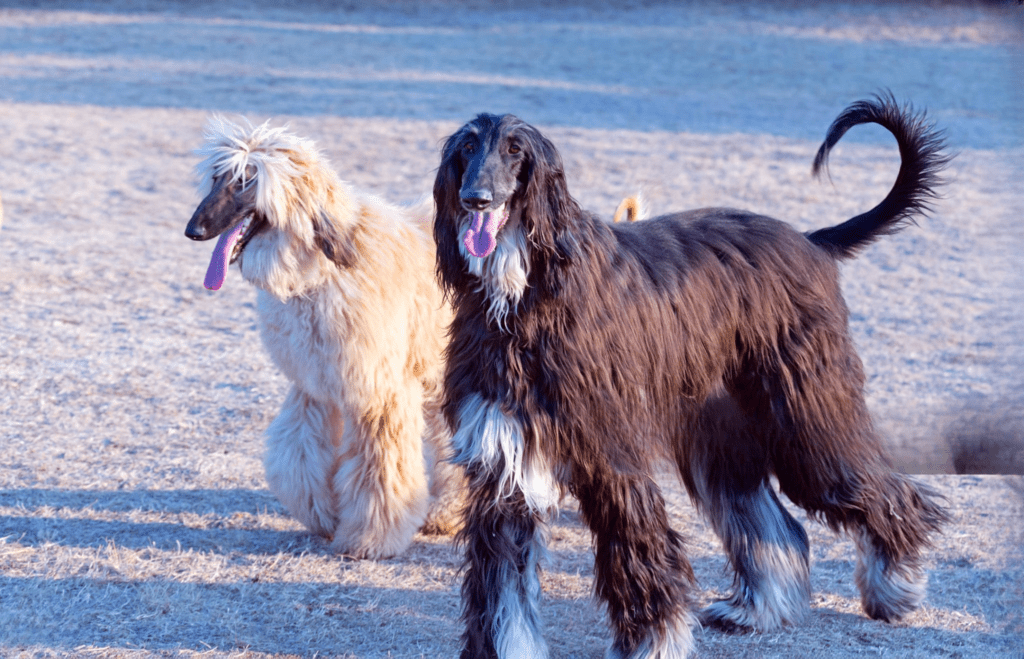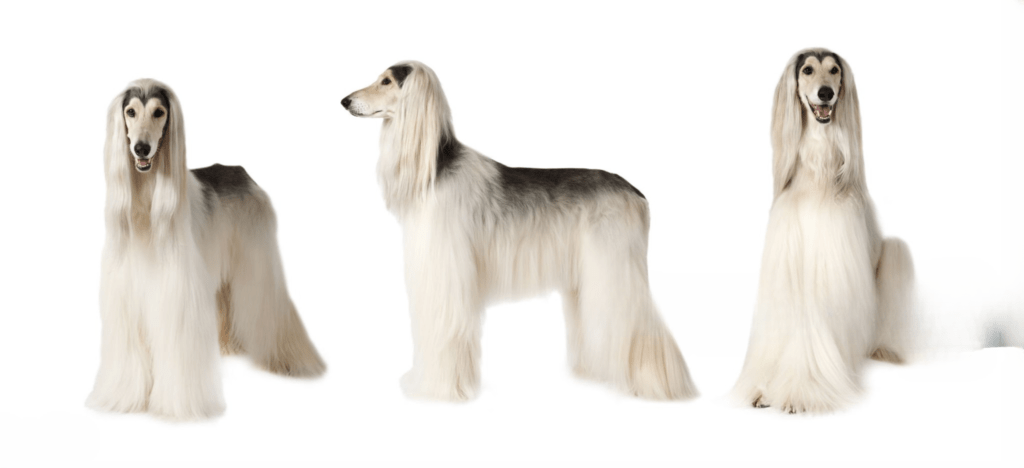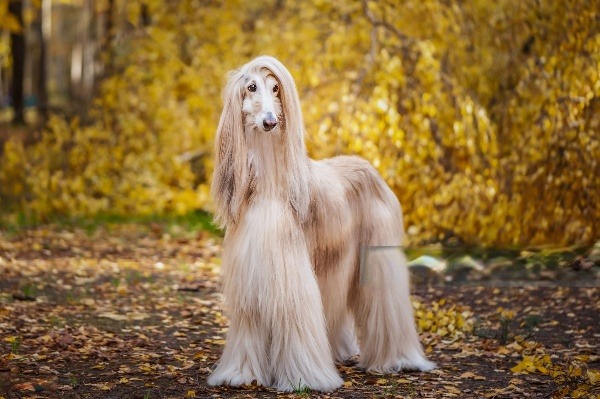The medium-sized, slim Afghan Hound breed of dog is renowned for its show-worthy features and long, silky coat. The breed name Tazi is thought to have originated in Afghanistan. The breed is renowned for its gentle, relatively quiet, and humorous nature around people they feel at ease with. They are also highly independent and self-assured.


The following are some traits of the Afghan Hound :-
- Group :- Hound
- Height :- 25 to 27 inches at the shoulder
- Weight :- About 50 to 60 pounds
- Coat :- Long, thick, and fine
- Coat colour :- Any colour or combination of colours, including brindle and domino
- Life span :- 12 to 14 years
- Temperament :- Dignified, silly, aloof, happy, independent, quiet
- Hypoallergenic :- Yes
- Origin :- Afghanistan
The DNA of Afghan hounds is more closely linked to ancient dogs than it is to popular modern breeds, making them one of nine ancient or “basal” breeds. Due to their speed, quick thinking on their own, and panoramic vision—qualities shared by all sighthounds—they have accompanied humans on hunting expeditions. The Afghans of today are mostly descended from English breeding programmes from the 1920s.
What is the average lifespan of an Afghan Hound?
An Afghan Hound lives for 12 to 14 years on average. This breed is renowned for having a quiet, peaceful, joyful, independent, and dignified temperament. Their coat is long, thick, and fine, and comes in a variety of colours, including brindle and domino. They are hypoallergenic. Afghan hounds are regarded as one of nine “basal” or ancient breeds, which means that their DNA is more closely linked to ancient dogs than to popular modern dog breeds. Humans have used them as hunting companions because they are fast, can think on their own, and have wide vision—qualities shared by all sighthounds. The Afghans of today are mostly descended from English breeding programmes from the 1920s.
Grooming of Afghan Hound ?


Afghan Hounds are well-known for having lengthy, silky coats that need constant maintenance.
The following advice can help you groom an Afghan hound :-
• Brushing :- To reduce tangles, Afghan Hounds require daily brushing. To remove tough mats or tangles, use an oval pin brush and a slicker brush. Using long, sweeping strokes and brushing in the direction of hair growth, thoroughly brush each section of the coat with the pin brush. Brush the legs starting at the top and working downward. To give the coat body and shield it from harm, use a conditioning spray at the end.
• Bathing :- Afghan Hounds require frequent bathing, preferably twice a week. Brush the dog well before giving it a bath in premium dog shampoo and conditioner (available at pet stores). Thoroughly rinse, but feel free to leave some conditioner behind. Use a standing hair dryer (or a hand-held one if one is not available) to dry the coat after the bath, being careful to brush the coat as you dry. After the coat has completely dried, brush it one more time and use conditioning spray for extra protection.
• Clipping :- Every two to three months, the dog’s hairstyle will determine how often clipping or scissoring is required. To maintain the condition of their dogs’ coats, many Afghan dog owners opt to take them to a professional groomer once a month. Every eight to ten weeks, your Afghan dog will require a haircut, regardless of its current hairstyle. A professional groomer can cut the fine, luxurious coat of this breed and offer owners general grooming advice for Afghan Hounds.
common health issues that affect this breed?
Sure, Afghan Hounds frequently have certain health problems. Several prevalent health concerns associated with this particular dog breed have been reported.
- Hip dysplasia
- Elbow dysplasia
- Juvenile cataracts
- Thyroid problems
- Laryngeal paralysis
- Von Willebrand disease
While not as common as in most other large breeds, hip dysplasia and elbow dysplasia do occur more frequently in Afghan Hounds than in other sighthound breeds. In Afghan Hounds, thyroid disease is most likely the main cause for concern. Thyroid dysfunction affects up to 30% of Afghan Hounds, depending on whose statistics you believe. Moreover, cataracts are a major concern, particularly if they develop in children under the age of one year, as they frequently result in blindness. Other eye conditions that can occasionally affect Afghan Hounds include corneal dystrophy and cherry eye. There have also been reports of retinal dysplasia, glaucoma, and progressive retinal atrophy (PRA).
What is the best diet for an Afghan Hound ?
An Afghan dog’s ideal diet is one that is well-balanced, suitable for their life stage, and meets their energy requirements. , it is advised to consume a range of nutrients, including fibre from vegetables and berries, healthy fats, vitamins, and minerals. It is not within the anatomy of a dog’s stomach to break down and ferment carbohydrates, which are the primary component of kibble.
The following dog foods are suggested for Afghan Hounds :-
1. Taste of the Wild High Prairie :- Real roasted meat, fruits, and vegetables are used to make this dog food. It has no artificial colours, flavours, or preservatives and is free of grains. Additionally, it has a lot of probiotics and antioxidants, which boost intestinal and immune system health. The cost of a 28-pound bag is $49.99.
2. The Honest Kitchen Grain-Free Dehydrated Dog Food :- This food is free of by-products, fillers, and preservatives and is made with ingredients of human grade. In addition, it doesn’t include any artificial flavours, colours, or preservatives and is free of grains. The cost of a 10-pound box is $88.19.
3. I and Love and You Dog Food :- Real meat, fruits, and vegetables are used to make this dog food. It has no artificial colours, flavours, or preservatives and is free of grains. Additionally, it has a lot of probiotics and antioxidants, which boost intestinal and immune system health. The cost of a 23-pound bag is $58.99.
It’s crucial to speak with your veterinarian before making dietary changes for your dog. Based on the particular requirements of your dog, they can provide you recommendations that are more detailed.
training of Afghan Hound ?


Because of their reputation for independence and aloofness, Afghan Hounds can be difficult to train. But you can train your Afghan Hound to be a docile and well-behaved friend if you are persistent and patient with them.
The following advice can help you train an Afghan hound :-
1. Get started early :- If at all possible, start training your Afghan hound when they are still puppies. They will be able to form positive habits and avoid negative ones from forming as a result.
2. Be kind :- Afghan Hounds are delicate canines that learn best from training techniques that emphasise gentle, positive reinforcement. Refrain from employing severe or punitive training methods as this may instil fear or aggression in them.
3. Socialise :- Afghan Hounds, who can be reticent around strangers, benefit greatly from socialisation more than other breeds of dogs. From a young age, introduce your dog to a variety of people, animals, and surroundings to help them grow more at ease and self-assured.
4. Be Consistent :- When training an Afghan Hound, consistency is essential. Make sure everyone in the household is on the same page and train using the same commands and rewards each time.
5. Apply positive reinforcement :- Give your Afghan dog affection, praise, and treats when they behave well. They will gain an understanding of what is expected of them from this and be motivated to behave well in the future.
6. Exercise patience :- Afghan Hounds may be more difficult to train than other breeds due to their stubborn nature. If your canine companion doesn’t pick up a command right away, be persistent and patient and don’t give up.
How much exercise does need?
Being athletic dogs, Afghan Hounds need a lot of exercise to maintain good health and happiness. An adult Afghan Hound is said to require approximately 90 minutes of exercise per day in order to maintain strength and health. This could be divided into several walks, but it can also involve play or other enriching activities. Engaging in games with your dog fosters a strong bond between you two while also giving them much-needed mental stimulation.
When your Afghan Hound is a puppy, it is advised that their formal walks be limited to five minutes per month of age. Even though this might not seem like much, puppies can get this much exercise just by running around the house or engaging in toy play. It’s critical to monitor their daily activity level because excessive exercise at this age can lead to problems with bone and muscle development in later life.
You might observe that your Afghan Hound is starting to slow down as they get closer to turning 7 years old. This simply indicates that they are starting their senior year, which is completely normal and causes no cause for concern. It might be necessary for you to start shortening their walks or scheduling more downtime. Letting your dog go at their own pace is the best way to accomplish this; you’ll soon be able to gauge how far they’re comfortable going.

